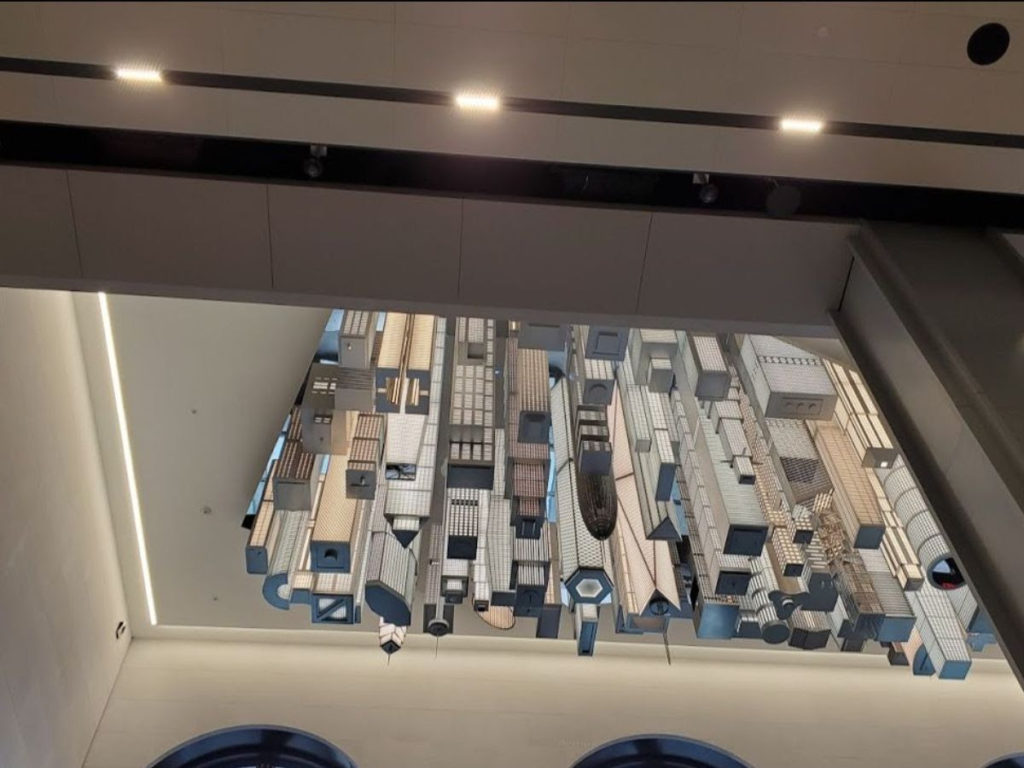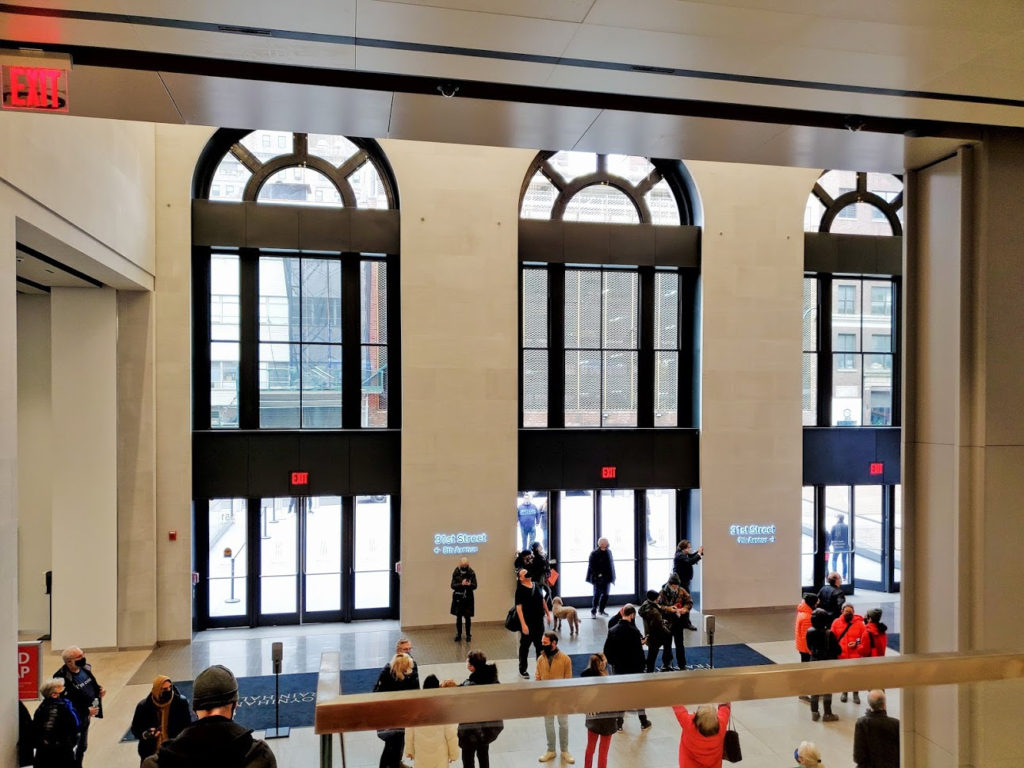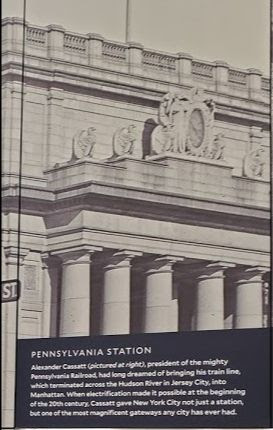Weekend Edition, January 2/3, 2021 – WOW…. COME TO SEE THE NEW TRAIN HALL!!!


252nd Edition
January 2-3, 2021
ALL ABOARD TO MOYNIHAN HALL FOR YOUR AMTRAK TRAIN

Your first view of the new concourse level as you enter from 8th Avenue.

From the upper level future food and retail area you can watch the comings and goings.

Great graphics hide the yet-to-be opened.

Great images roll across the light and airy concourse. Escalators lead down to tracks, the same way as the original Penn Station.
Look above the 31st Street Mid-block entrance for a skyscraper art piece… Remember to look up.

Look above the 33rd Street Mid-block entrance for an interesting “stained glass” artwork.
In the new baggage claim room is a history of Pennsylvania Station. This reminded me of the fate of the grand clock and Day and Night Sculpture that ended up in Kansas City, Missouri

Eagle Scout Memorial Fountain, 39th Street at Gillham Road,Kansas City, Missouri, featuring the only remaining assembled example of the four “Day” and “Night” statue pairs by Adolph Weinman that once flanked clocks in New York City’s original Penn Station (1910–1963).
THERE ARE NO TRAINS TO BE SEEN ABOVE THE TRACK LEVEL AT MOYNIHAN HALL. ENJOY THESE FROM THE SMITHSONIAN AMERICAN ART MUSEUM.

Saul Berman, (Study for mural, The Railroads Came to Town), n.d., watercolor, Smithsonian American Art Museum, Transfer from the Internal Revenue Service through the General Services Administration , 1962.8.26

- Edward Mitchell Bannister, Train, ca. 1875-1880, oil on canvas, Smithsonian American Art Museum, Gift of Frederick and Joan Slatsky, 1983.95.107
- Edward Bannister’s painting shows a train cutting through a rural landscape, where a railroad trestle interrupts the flow of the stream below. These familiar signs of progress in the nineteenth-century landscape highlight a concern shared by many of Bannister’s fellow painters, who worried that industrialization would soon destroy their nation’s natural beauty.

Hugo Robus, Train in Motion, ca. 1920, oil on canvas mounted on fiberglass, Smithsonian American Art Museum, Gift of Mr. and Mrs. Hugo Robus, Jr., 1978.153.2
Hugo Robus created Train in Motion toward the end of his painting career, shortly before he devoted all of his time to sculpture. He was fascinated by the futurist painters, who emphasized the speed and power of modern machinery, but claimed not to be “initiated into their plane of intelligence” when he tried to understand the movement’s principles (Tarbell, Hugo Robus, 1885–1964, 1980). The repeated shapes and blurred colors in this painting express a sense of movement, as if we are watching the landscape sweep past the window of a speeding train. The bright colors and fragmented shapes appear like a kaleidoscope, suggesting that this image is just one of an infinite number of possibilities.
“I [am] interested not in what the eye records but in what our sensitivities feel.” Robus, “Sculptor as Self Critic,” reprinted in Tarbell, Hugo Robus, 1885–1964, 1980

Jack Savitsky, Train in Coal Town, 1968, oil on fiberboard, Smithsonian American Art Museum, Gift of Herbert Waide Hemphill, Jr. and museum purchase made possible by Ralph Cross Johnson, 1986.65.137 Jack Savitsky’s Train in Coal Town depicts a coal-fired passenger train traveling between Pottsville and Silver Creek, two well-known coal towns in Pennsylvania. Behind the smoky plume of the locomotive stand a blue-gray coal breaker and eight mill houses—the very houses that make up the painting’s border. Savitsky conveys the sameness and unending work of the company town through his use of repetitive patterning and decorative elements. However, the lively colors and cheerful rural setting also reflect an energetic spirit within the miner community

Steve Ashby, Train in Landscape, n.d., carved wood with applied wood pieces, Smithsonian American Art Museum, Gift of Herbert Waide Hemphill, Jr., 1998.84.4

Louis Lozowick, Train and Factory, 1933, lithograph on paper, Smithsonian American Art Museum, Gift of Adele Lozowick, 1986.81.7, © 1933, Lee Lozowic

Doris Rosenthal, Night Train, n.d., lithograph on paper, Smithsonian American Art Museum, Bequest of the artist, 1976.46.3

Ernest Ralph Norling, Sketch for mural of The Mail Train, n.d., watercolor on paperboard: illustration board, Smithsonian American Art Museum, Transfer from the Internal Revenue Service through the General Services Administration , 1962.8.40

Unidentified, Pennsylvania Railroad Locomotive at Altoona Repair Facility, ca. 1868, albumen silver print, Smithsonian American Art Museum, Museum purchase from the Charles Isaacs Collection made possible in part by the Luisita L. and Franz H. Denghausen Endowment, 1994.91.213

Dox Thrash, Railroad Yard, ca. 1933-1934, aquatint, etching and pencil on paper, Smithsonian American Art Museum, Museum purchase, 1981.11.2

Max Arthur Cohn, Railroad Bridge, opaque watercolor, Smithsonian American Art Museum, Gift of the artist, 1984.63.3

Jack J. Greitzer, Concerning Railroads, n.d., crayon and chalk on paper, Smithsonian American Art Museum, Transfer from the U.S. Department of the Interior, National Park Service, 1965.18.21
WEEKEND PHOTO
SEND IN YOUR SUBMISSION
ROOSEVELTISLANDHISTORY@GMAIL.COM
WIN A TRINKET FROM THE KIOSK SHOP

FRIDAY PHOTOS OF THE DAY
NO ONE GUESSED THE INTERIOR
OF THE CLOSED BLACKWELL’S ISLAND PENITENTIARY

EDITORIAL
What a treat today. I had visited the closed area at the Farley Post Office years ago with an engineer. It was empty, bleak and depressing. Little could I imagine that today it is a sparkling re-birth of this building.
The use is complicated for Moynihan Hall.
All Amtrak trains load from this station. When an Amtrak train arrives you can depart from 7th Avenue or Moynihan Hall.
New Jersey Transit still uses Track 1-4 in the 7th Avenue Building, so that has not changed.
LIRR uses tracks 17-21 which are only in the 7th Avenue Building. Other tracks for LIRR trains can be accessed through Moynihan Hall.
There is a Starbucks open already. There are areas for ticketed passengers with restrooms. I spotted restrooms by the 31St. Midblock exit.
IF YOU WANT TO SEE WHAT THIS BUILDING LOOKED LIKE 4 YEARS AGO, CHECK OUT UNTAPPED CITIES:
Text by Judith Berdy
Thanks to Bobbie Slonevsky for her dedication to Blackwell’s Almanac and the RIHS
Thanks to Deborah Dorff for maintaining our website
Edited by Deborah Dorff
All image are copyrighted (c)
SMITHSONIAN AMERICAN ART MUSEUM
ROOSEVELT ISLAND HISTORICAL SOCIETY
JUDITH BERDY
FUNDING PROVIDED BY ROOSEVELT ISLAND OPERATING CORPORATION PUBLIC PURPOSE GRANTS CITY COUNCIL REPRESENTATIVE BEN KALLOS DISCRETIONARY FUNDING THRU DYCD


Copyright © 2020 Roosevelt Island Historical Society, All rights reserved.
Our mailing address is:
rooseveltislandhistory@gmail.com





Leave a comment